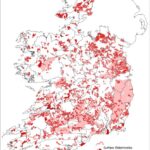The implementation of the Urban Wastewater Treatment Directive has led…
Significant Pressures: Domestic Waste Water
Domestic wastewater treatment systems (DWWTSs) are used to treat sewage, in the case where a house or premises is not connected to the main sewer. There are nearly half a million DWWTSs within Ireland, and the majority of these are septic tanks which serve single residential houses. They also include a smaller number of treatment systems that are designed for up to 500 people, generally found in businesses, leisure centres and hotels. Developer Provided Infrastructure (DPI) in housing estates which have not been taken in charge by the public authorities and do not have their water services connected to the public network managed by Uisce Éireann, are also included in this category.
These facilities can cause pollution issues due to their discharges where systems are sub-standard and/or are poorly maintained. Discharges from DWWTSs have been identified as the sixth most prevalent significant pressure in Ireland, impacting approximately 9% of all waterbodies ‘At risk’ of not achieving their environmental objective under the Water Framework Directive. This is based on the most recent characterisation assessment using data up to 2021.
In total, there are 148 water bodies that have a significant impact from domestic wastewater discharge. These are broken down as follows:
- 78% from single house discharges;
- 20% from communal discharges and;
- Approximately 2% from unauthorised discharges that should be covered under Section 4 licences.
Of the 148 waterbodies with DWWTS discharge as a significant pressure, based on available data, discharges from DPI has been identified as causing impacts in approximately 18 waterbodies.







